When you order a pizza on your phone you start by picking the toppings (no pineapple, obviously), sauce, crust type, and add any extras. Your order is then processed by the POS system. Through automation the pizza shop automatically receives your order and you receive an email confirmation with an estimated delivery time.
That’s marketing automation: a series of automatic processes triggered by a specific action or signal. Marketing automation takes care of tedious processes, like confirming pizza orders, and automates them in the back end to improve efficiency.
In this article we explain what B2B marketing automation is and how it works. I’ll explain how it works and show you some real world examples of how B2B marketing automation can benefit your workflows.
Related reading: 5 Ways our Clients Use Marketing Automation To Simplify Success
How marketing automation works and what it can do
- At a basic level, your marketing automation platform provides you a section of code which you place in the back-end of your website’s code.
- This code allows your marketing automation platform to “see” every visitor who comes to your site.
- Each visitor is tracked individually: their behavior, actions, traffic source and the details they provide your business.
- This information is sent to your marketing automation platform, where you can view each visitor’s details individually.
- By manually setting up lists or segments, you can place individual visitors into larger groupings based on actions they’ve all taken, ways in which they’ve all engaged, places they are in the world (or your sales funnel), and more.
- You can also trigger automatic actions to occur when a visitor or lead meets a specific condition. This can be anything from an email being sent, a retargeting ad being delivered, a change being made to your website’s design, and more.
What B2B marketing automation looks like
Here’s a screenshot of a list of website visitors being tracked by our CRM platform:

On the right side you can see the actions of one particular visitor (codename 4f38aq4kae1f7u1h) who’s been selected.
Here’s a screenshot of all the leads currently active on our website:
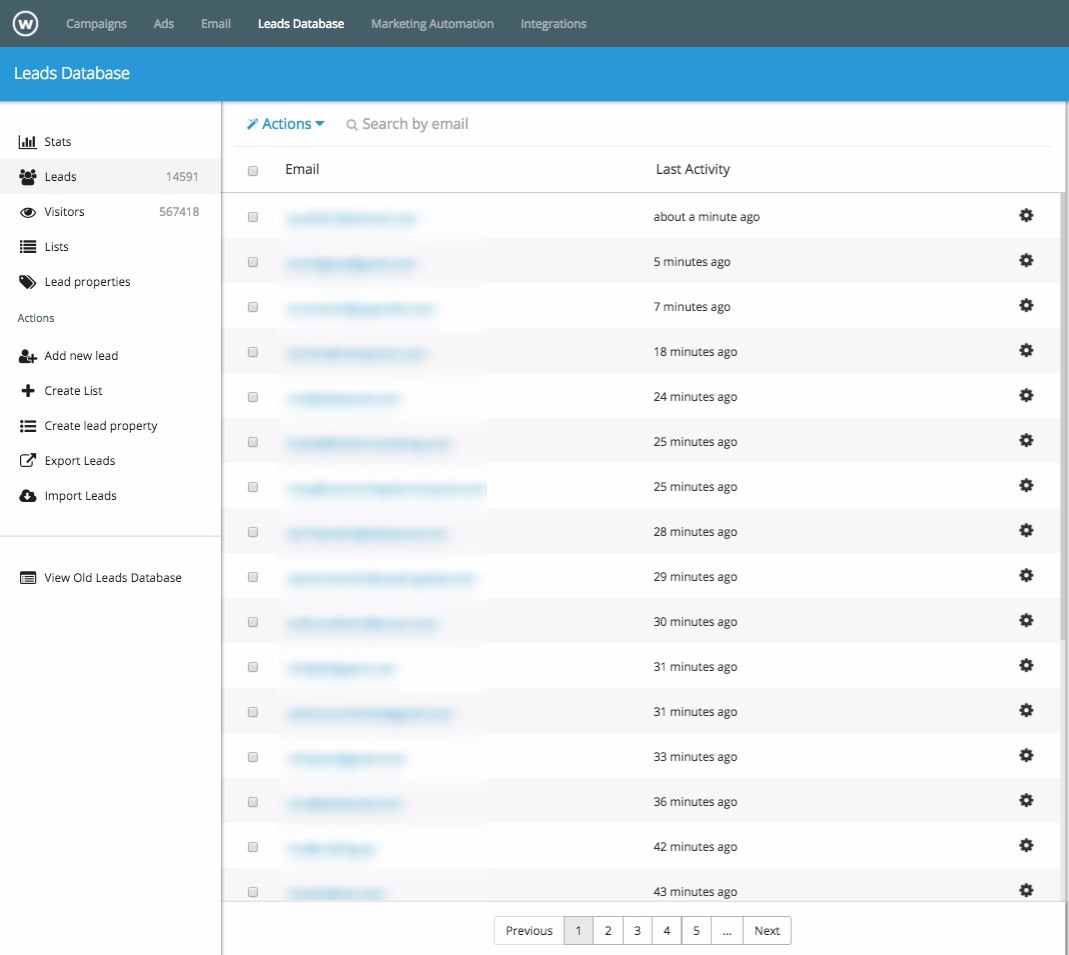
If you were to select any of those leads, you’d see each action they’ve ever taken on our site or piece of information they’ve provided our business.
To get more specific, here’s a screenshot of all the leads who converted on one of our popups (this list is automatically created when you create a campaign):
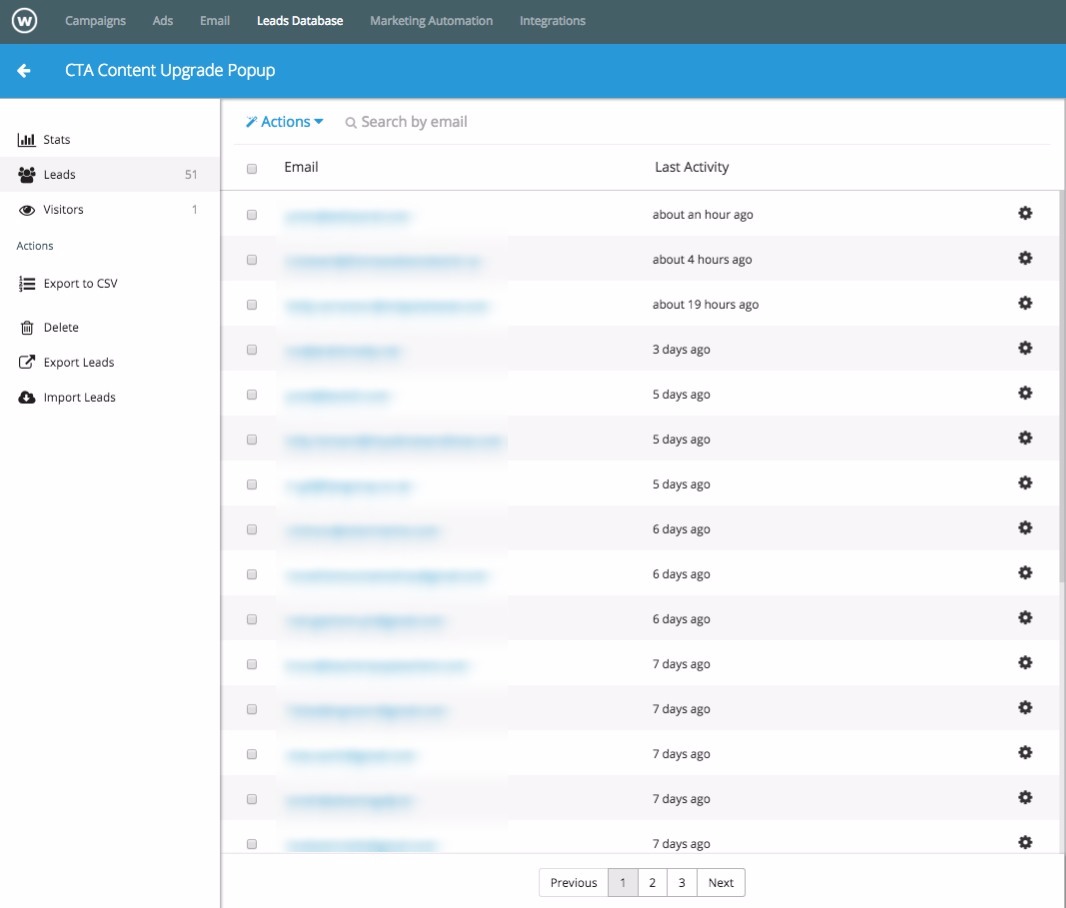
This is where B2B marketing automation starts, with a trigger. Converting on a popup on the Wishpond website and signing up for a free trial, for example, is a trigger. It sends a signal to our marketing automation system to send out a “thank you for signing up” email to get our new user started with Wishpond.
Marketing Automation Example for B2B Lead Nurturing
Here’s a simple example of a landing page built to capture information from a visitor:
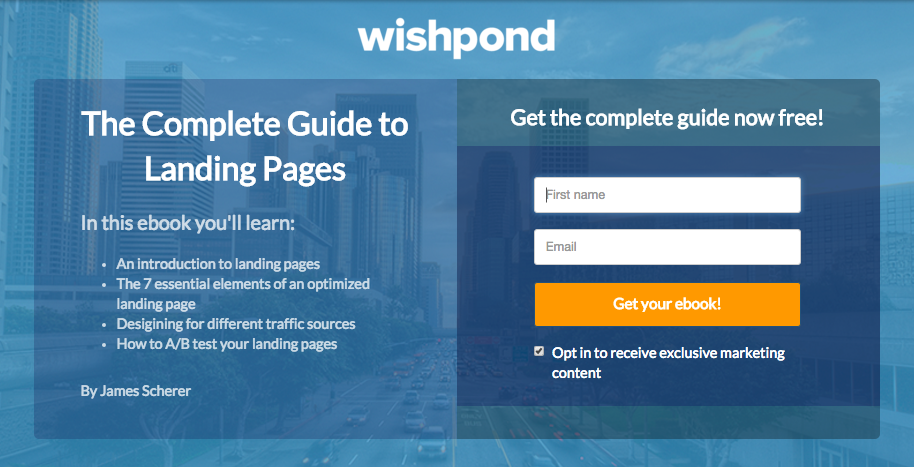
Once you’ve created your landing page (which you can do right within the Wishpond platform) and published it to your website, you choose your nurturing content and write your nurturing emails.
For more on lead nurturing content and emails, check out my article How to Create Email Drip Campaigns to Nurture Leads.
Firstly, set your conditions…

This is pretty straightforward: all leads who have converted on our landing page meet the condition for our workflow.
Next, let’s set the actions for this workflow. Essentially, this is the answer to the question “what’s going to happen after a lead meets the above conditions?”

I’ve set a 7 minute delay after the initial condition is met (conversion) and then 2 or 3 days between all the subsequent drip emails being sent. I send them around the same time every day to better personalize the campaign.
Here’s a screenshot of a separate workflow which stops the early-stage funnel and moves our leads to the next stage:
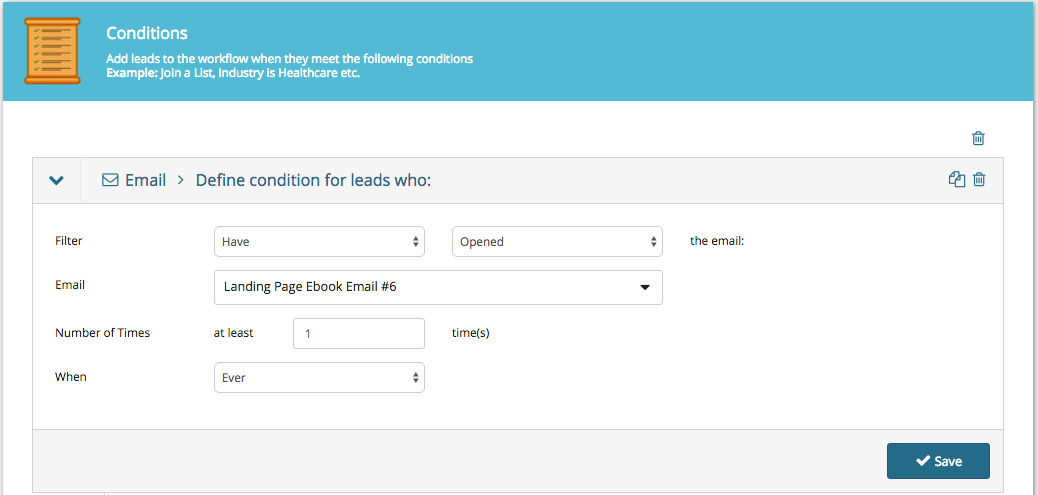
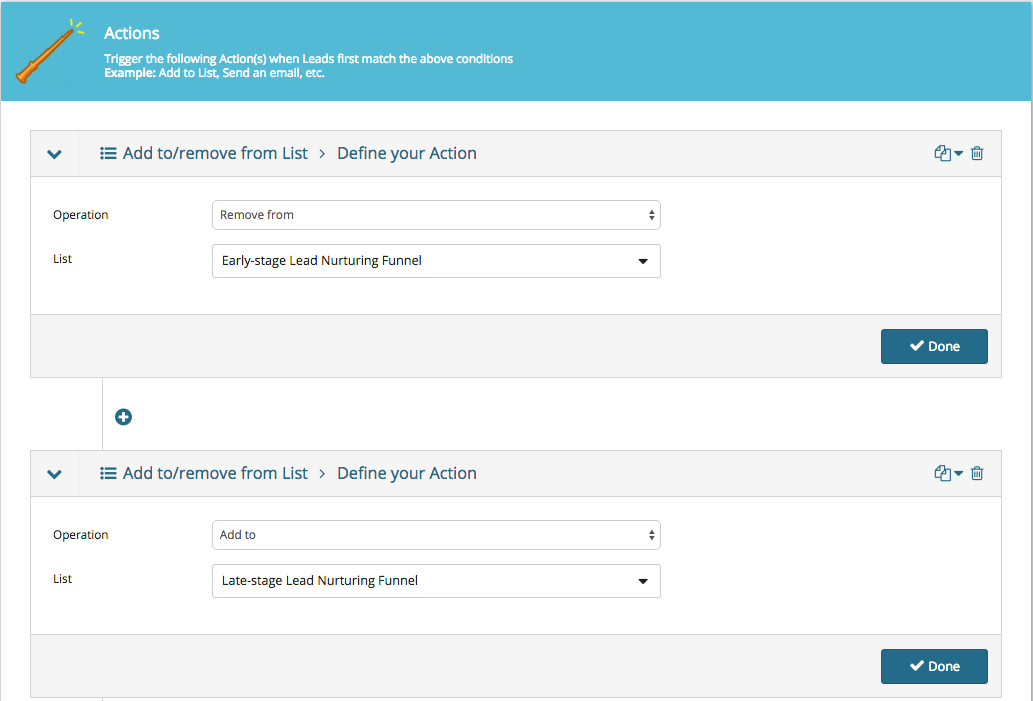
If they opened but didn’t click through (or didn’t open), set an action which places them either into a general lead nurturing drip email flow or simply your newsletter mailout.
If your workflow’s conversion goal isn’t a paid plan (but rather a late-stage drip campaign, perhaps) simply set the conditions accordingly.
And in case you were wondering, by default all of Wishpond’s workflows are set up for each lead to only be able to meet the conditions once.
For the full guide to creating a lead-nurturing drip campaign, check out my article “How to Create Email Drip Campaigns to Nurture Leads”.
Marketing Automation Example for B2B Customer Retention
The B2B market is sometimes focused not on lead generation or nurturing but on getting that initial sale and driving repeat customers.
A lot of this is done through hard work, sweat and tears: sales associates and account managers grinding it out to get the job done.
But what if it were a bit easier? What if all it would take would be 5 minutes and the click of a few buttons?
Let’s say your B2B company sold office paper to large businesses and a three-month sales cycle (before the customer runs out of paper and you re-sell).
Let’s break down how marketing automation can help:
Step #1: Every time your salespeople secure a business’ patronage, they add that business’ contact details to a “Customers” list. Your customers are likely already in the marketing automation system (as leads) but if not, it’s easy to add their name and all the details you have:

Step #2: Create a simple workflow for all people who are within your “Customers” list.
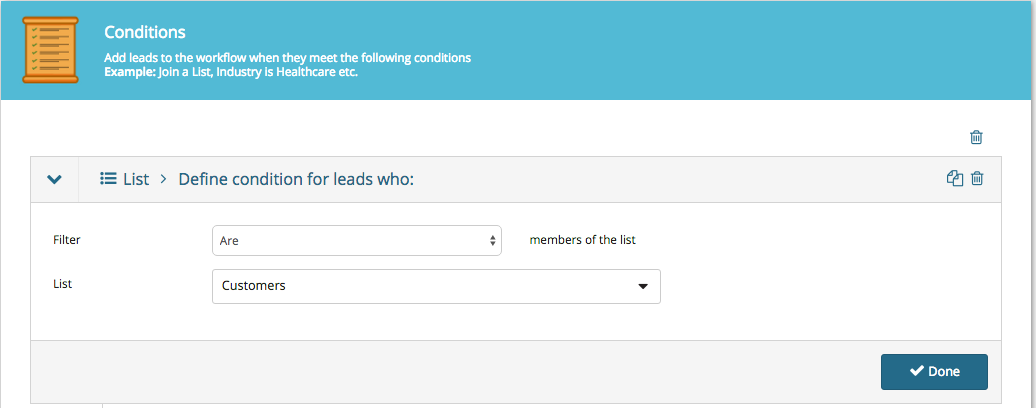
Every time you add someone to your “Customers” list they’ll meet the workflow’s conditions and the actions below will be started:
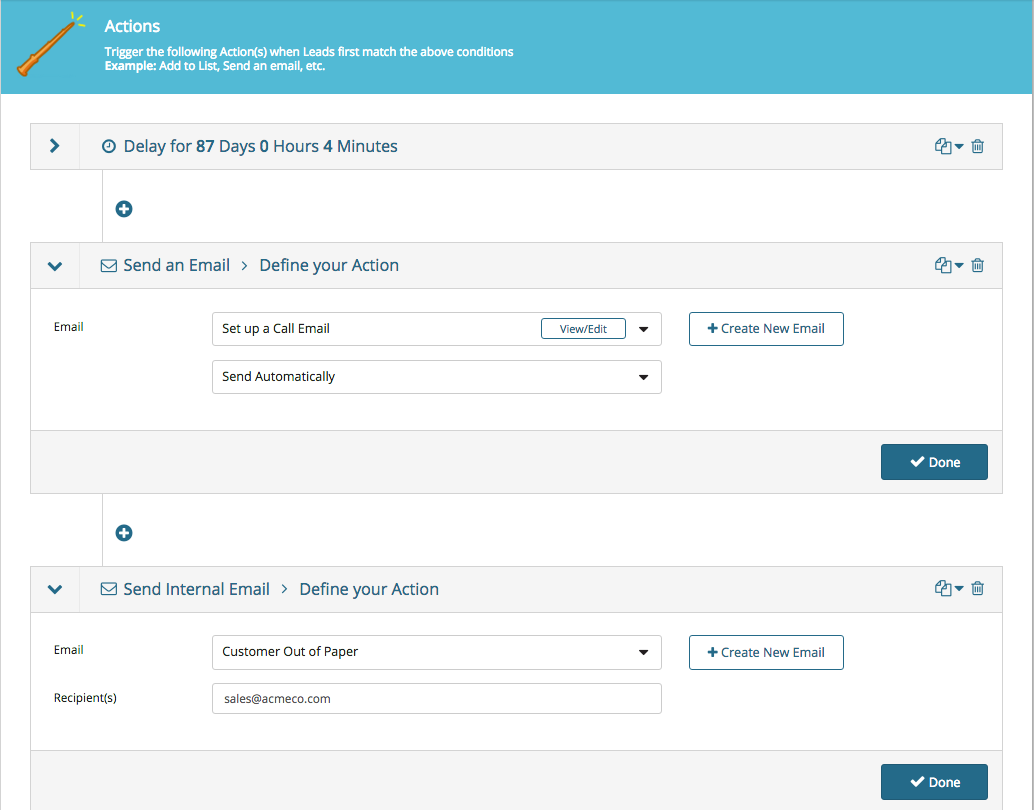
Because the business has a three month sales cycle, we set an automatic “are you ready to buy more paper?” email with an 87-day delay (this, of course, needs to be tested).
We also send an internal email to the sales team notifying them that one of their accounts may need a call.
Note: Remember to set the the automatic “are you ready to buy more paper?” email to be from the sales team so they receive an email if the account responds).
This whole process takes a few minutes, 90% of which is the writing of the emails themselves.
Wrapping it Up
These are just simple suggestions for how your B2B company can use marketing automation to make your work life easier, as well as more optimized.
There are endless opportunities within marketing automation, from simple lead nurturing emails to dynamic website personalization, retargeting and more. If you can think it, marketing automation can do it.
Related Reading:
- The Ultimate Guide to B2B Marketing: Strategies, Tips, & Examples
- How B2B Marketers Can Control the Buying Process With Buyer’s Guides
- B2B Email Drip Campaign Ideas and Examples
- The Ultimate Guide to B2B Marketing: Strategies, Tips, & Examples

